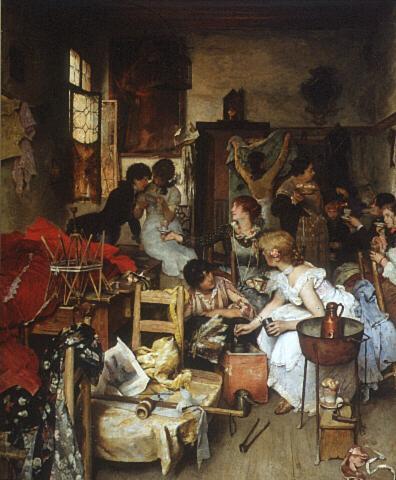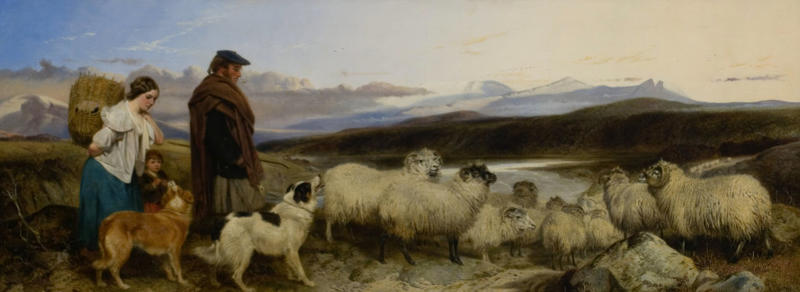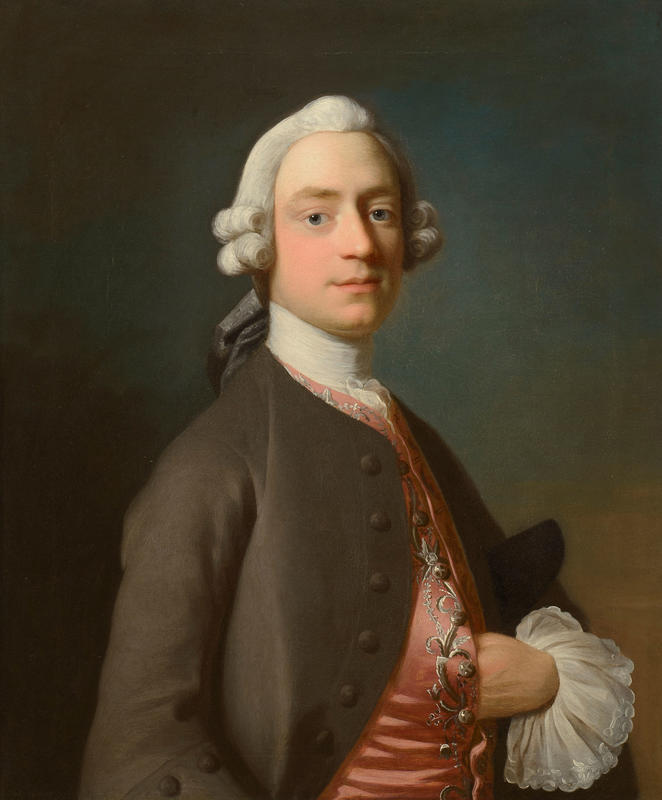—

exhibition Details
The eighteenth and nineteenth centuries saw huge changes in Britain. The nation's power base continued to shift from the monarchy to one where Court and Parliament had a shared role. Britain became an imperial power, its dominion extending around the globe. Known as the Age of Enlightenment, radical ideas about taste, science, economics, literature and art brought about a new understanding of the world. A specific British culture emerged, one that spoke of individual achievement, and where the new middle classes acquired land and personal wealth to match that of the gentry. Enclosure of common land brought agricultural benefits for landowners, but drove many of the poor to eke out a living in the cities. While France suffered major social upheavals through revolution, dissension in Britain never brought down the state. Queen Victoria's long and peaceful reign in the nineteenth century occurred alongside further rapid changes in the face of industrial development.
Whereas in the seventeenth century almost all of the painters attached to the Court originated from Holland, Belgium and France, William Hogarth (1697-1764) heralded an era that has since been described as the Golden Age of British Painting. For the first time, artists created works that spoke of the rich variety of their own time - an age of discovery from which Britannia arose triumphant, childhood was invented, and women began to question their place in society. Ordinary people became a legitimate subject for art, and satirists lampooned kings, courtiers and country folk in equal measure. Every aspect of British life came under the scrutiny of the artist, whose works remain a rich and satisfying record of the age.
- Date
- —
- Curated by
- Mary Kisler
- Location
- New Gallery
- Cost
- Free entry
Related Artworks
Cleopatra
oil on panel
Mackelvie Trust Collection, Auckland Art Gallery Toi o Tāmaki, purchased 1916
Egyptians 3,000 years ago
oil on panel
Mackelvie Trust Collection, Auckland Art Gallery Toi o Tāmaki, purchased 1921
Satan dismayed
bronze
Mackelvie Trust Collection, Auckland Art Gallery Toi o Tāmaki, bequest of James Tannock Mackelvie, 1885
Miss Windham
oil on canvas
Auckland Art Gallery Toi o Tāmaki, purchased with assistance from the Friends of the Auckland Art Gallery, 1976
On display
For of such is the Kingdom of Heaven
oil on canvas
Mackelvie Trust Collection, Auckland Art Gallery Toi o Tāmaki, purchased 1913
The Car of Love, or Love's Wayfaring
pastel, brush drawing and charcoal
Auckland Art Gallery Toi o Tāmaki, gift of Viscount Leverhulme, 1924
Portrait of Anne Howard-Vyse (1754-1784)
On display
Portrait of Fifth Viscount Allen, named Joshua (1728-1816) in the Uniform of a Lord Lieutenant
oil on canvas
Mackelvie Trust Collection, Auckland Art Gallery Toi o Tāmaki, purchased 1975
On display
The Holiday (Still on Top)
On display
Hercules resting
bronze
Mackelvie Trust Collection, Auckland Art Gallery Toi o Tāmaki, bequest of James Tannock Mackelvie, 1885
Grace
oil on canvas
Mackelvie Trust Collection, Auckland Art Gallery Toi o Tāmaki, purchased 1925
The Spirit of Justice
oil on canvas
Mackelvie Trust Collection, Auckland Art Gallery Toi o Tāmaki, gift of James Tannock Mackelvie, 1881
Veduta del sotterraneo Fondamento del Mausoleo, che fu eretto da Elio Adriano Imp ... (View of the subterranean foundatins of the Mausoleum built by the Emperor Hadrian ...) Vertical section of the buttresses of Hadrian's mausoleum (Spaccato degli Speroni, i quali servono de contrafforti al gran fondamento del Mauso d'elio Adriano)
etching
Mackelvie Trust Collection, Auckland Art Gallery Toi o Tāmaki, bequest of Dr Walter Auburn, 1982
Untitled (Hound Chasing a Hare)
oil on canvas
Mackelvie Trust Collection, Auckland Art Gallery Toi o Tāmaki, gift of a private donor, 2001
Shakespeare: Tempest, Act I, Scene II
mezzotint and dust-ground aquatint on wove paper
Auckland Art Gallery Toi o Tāmaki, gift of Peter Tomory, 2002
Shakespeare: Macbeth, Act I, Scene III
mezzotint on wove paper
Auckland Art Gallery Toi o Tāmaki, gift of Peter Tomory, 2002
Shakespeare: Second Part of King Henry the Fourth, Act II, Scene IV
mezzotint on wove paper
Auckland Art Gallery Toi o Tāmaki, gift of Peter Tomory, 2002
A Harlot's Progress
engraving
Auckland Art Gallery Toi o Tāmaki, gift of Dr Walter Auburn through the Friends of the Auckland Art Gallery, 1979
The Quarrel with her Protector
engraving
Auckland Art Gallery Toi o Tāmaki, gift of Dr Walter Auburn through the Friends of the Auckland Art Gallery, 1979
Apprehended by a Magistrate
engraving
Auckland Art Gallery Toi o Tāmaki, gift of Dr Walter Auburn through the Friends of the Auckland Art Gallery, 1979
Scene in Bridewell Prison
engraving
Auckland Art Gallery Toi o Tāmaki, gift of Dr Walter Auburn through the Friends of the Auckland Art Gallery, 1979
She Expires while the Doctors are Quarrelling
engraving
Auckland Art Gallery Toi o Tāmaki, gift of Dr Walter Auburn through the Friends of the Auckland Art Gallery, 1979
The Funeral
engraving
Auckland Art Gallery Toi o Tāmaki, gift of Dr Walter Auburn through the Friends of the Auckland Art Gallery, 1979
At the Fair
On display
Veduta di Piazza Navona sopra le rovine del Circo Agonale (View of Piazza Navona above the ruins of the Circus Agonalis [Circus of Domitian])
etching
Auckland Art Gallery Toi o Tāmaki, Peter Tomory Collection, purchased 2004
Sketch of the head of the Farnese Hercules
black chalk on grey paper
Auckland Art Gallery Toi o Tāmaki, gift of Miss Nella Hickson, 1944
Landscape
black and white chalk on grey paper
Auckland Art Gallery Toi o Tāmaki, purchased 1956
King George I
oil on canvas
Auckland Art Gallery Toi o Tāmaki, gift of His Excellency the Governor General, Sir Willoughby Norrie, 1957
On display
Hadrian's Villa
On display
Two tigers in a rocky landscape
On display
Two Young Herdsmen
stipple engraving
Auckland Art Gallery Toi o Tāmaki, gift of Mr J F S Briggs, 1959
A Rustic Scene with Sheep and Shepherds
On display
Portrait of a Man
oil on canvas
Auckland Art Gallery Toi o Tāmaki, purchased with assistance from the Friends of the Auckland Art Gallery, 1976
On display
By the Rivers of Babylon (design for a stained glass window, Kirkcaldy)
charcoal
Auckland Art Gallery Toi o Tāmaki, gift of Viscount Leverhulme, 1924. Frame restoration sponsored by Elly Blanche
Jephthah's Daughter (design for a stained glass window in St Giles Cathedral, Edinburgh)
charcoal
Auckland Art Gallery Toi o Tāmaki, gift of Viscount Leverhulme, 1924. Frame restoration sponsored by Elly Blanche
The Morning Walk, Squire Hallett and his Wife
colour mezzotint
Auckland Art Gallery Toi o Tāmaki, purchased 1926
Study for the three witches in Macbeth
oil on canvas
Auckland Art Gallery Toi o Tāmaki, purchased with funds from the M A Serra Trust, 1980
On display
Captain O'Kelly's "Eclipse"
On display
Farnese Hercules
bronze
Mackelvie Trust Collection, Auckland Art Gallery Toi o Tāmaki, bequest of James Tannock Mackelvie, 1885
The Proposal (Reflections in Shadows)
oil on canvas
Mackelvie Trust Collection, Auckland Art Gallery Toi o Tāmaki, bequest of James Tannock Mackelvie, 1885
Blind Beggar of Assisi
oil on canvas
Mackelvie Trust Collection, Auckland Art Gallery Toi o Tāmaki, bequest of James Tannock Mackelvie, 1885
A Sketch: The Proposal
oil on cardboard
Mackelvie Trust Collection, Auckland Art Gallery Toi o Tāmaki, bequest of James Tannock Mackelvie, 1885
Joshua Reynolds
oil on paper, mounted on canvas
Mackelvie Trust Collection, Auckland Art Gallery Toi o Tāmaki, bequest of James Tannock Mackelvie, 1885
Ceres in search of Proserpine
On display
The Day of Sedgemoor
oil on canvas
Mackelvie Trust Collection, Auckland Art Gallery Toi o Tāmaki, purchased 1921
Portrait of John Sparrowe Esq
oil on canvas
Mackelvie Trust Collection, Auckland Art Gallery Toi o Tāmaki, purchased 1956
On display
Portrait of the Hon Mrs Boyle
oil on canvas
Mackelvie Trust Collection, Auckland Art Gallery Toi o Tāmaki, purchased 1956
On display
George Lavington, Bishop of Exeter
oil on canvas
Mackelvie Trust Collection, Auckland Art Gallery Toi o Tāmaki, purchased 1960
On display
Landscape
On display
Fishing Boats off Ramsgate
On display
The Wreck of a transport ship
oil on canvas
Mackelvie Trust Collection, Auckland Art Gallery Toi o Tāmaki, purchased 1956
On display
A Calm Morning on the Suffolk Coast
On display
Hay Barges
watercolour, gouache, pencil
Mackelvie Trust Collection, Auckland Art Gallery Toi o Tāmaki, gift of James Tannock Mackelvie, 1884
A Country Race Meeting
pen and watermark
Mackelvie Trust Collection, Auckland Art Gallery Toi o Tāmaki, bequest of James Tannock Mackelvie, 1885
A Master of Arts And a Mistress of Arts or The Don Caught Napping
pen and watercolour
Mackelvie Trust Collection, Auckland Art Gallery Toi o Tāmaki, bequest of James Tannock Mackelvie, 1885
The Bird Seller
pencil, pen and watercolour
Mackelvie Trust Collection, Auckland Art Gallery Toi o Tāmaki, bequest of James Tannock Mackelvie, 1885
A Helping Hand
pen and watercolour
Mackelvie Trust Collection, Auckland Art Gallery Toi o Tāmaki, bequest of James Tannock Mackelvie, 1885
Doctors and Patient
pen and watercolour
Mackelvie Trust Collection, Auckland Art Gallery Toi o Tāmaki, bequest of James Tannock Mackelvie, 1885
Elopement
pen, watercolour and pencil
Mackelvie Trust Collection, Auckland Art Gallery Toi o Tāmaki, bequest of James Tannock Mackelvie, 1885
Smugglers
pen and watercolour
Mackelvie Trust Collection, Auckland Art Gallery Toi o Tāmaki, bequest of James Tannock Mackelvie, 1885
The Oyster Girl
pen and watercolour
Mackelvie Trust Collection, Auckland Art Gallery Toi o Tāmaki, bequest of James Tannock Mackelvie, 1885
Landscape Study: River and Bridge
sepia
Mackelvie Trust Collection, Auckland Art Gallery Toi o Tāmaki, bequest of James Tannock Mackelvie, 1885
Beauty directed by Prudence rejects with Scorn the Solicitations of Folly
stipple engraving
Auckland Art Gallery Toi o Tāmaki, purchased 2003
Woman and Child
stipple engraving
Auckland Art Gallery Toi o Tāmaki, gift of J F S Briggs, 1959
Master James Hay
On display
Mrs Fuseli sleeping
pen and brown ink, with grey, blue and pink wash, body colour
Auckland Art Gallery Toi o Tāmaki, purchased 1965
Portrait of Mr John Fowler
On display
Portrait of Mrs Martha Fowler
On display
Woman and Child, Man Carrying Wand
stipple engraving
Auckland Art Gallery Toi o Tāmaki, gift of Mr J F S Briggs, 1959
Arrested for debt
engraving
Auckland Art Gallery Toi o Tāmaki, gift of Professor and Mrs A G Bogle, 2002
The Tavern Scene
engraving
Auckland Art Gallery Toi o Tāmaki, gift of Professor and Mrs A G Bogle, 2002
Surrounded by Artists and Professors
engraving
Auckland Art Gallery Toi o Tāmaki, gift of Professor and Mrs A G Bogle, 2002
The Young Heir takes Possession
engraving
Auckland Art Gallery Toi o Tāmaki, gift of Professor and Mrs A G Bogle, 2002
Married to an Old Maid
engraving
Auckland Art Gallery Toi o Tāmaki, gift of Professor and Mrs A G Bogle, 2002
Scene in a Gambling House
engraving
Auckland Art Gallery Toi o Tāmaki, gift of Professor and Mrs A G Bogle, 2002
The Prison Scene
engraving
Auckland Art Gallery Toi o Tāmaki, gift of Professor and Mrs A G Bogle, 2002
Scene in a Mad House
engraving
Auckland Art Gallery Toi o Tāmaki, gift of Professor and Mrs A G Bogle, 2002
Chelsea Reach
pen and watercolour
Mackelvie Trust Collection, Auckland Art Gallery Toi o Tāmaki, bequest of James Tannock Mackelvie, 1885
Camera sepolcrale inventata a disegnata conforme al costume, e all' antica magnificenza degl' Imperatori Romani (Imaginary sepulcral chamber designed according to the fashion and ancient magnificence of the Roman Emperors ...)
etching
Mackelvie Trust Collection, Auckland Art Gallery Toi o Tāmaki, bequest of Dr Walter Auburn, 1982
Gruppo di Colonne, che regge due archi d'un gran Cortile ... (Group of columns which support two arches of a great courtyard ...)
etching
Mackelvie Trust Collection, Auckland Art Gallery Toi o Tāmaki, bequest of Dr Walter Auburn, 1982
Vindicibus et Protectoribus Bonarum Artium I B Piranesius. (G B Piranesi [dedicates this work] to the Champions and Defenders of the Fine Arts). Frontispiece to Volume IV A monumental Roman harbour
etching
Mackelvie Trust Collection, Auckland Art Gallery Toi o Tāmaki, bequest of Dr Walter Auburn, 1982
The Toll Gate
pen and watercolour
Mackelvie Trust Collection, Auckland Art Gallery Toi o Tāmaki, bequest of James Tannock Mackelvie, 1885
Before the Ball
pen and watercolour
Mackelvie Trust Collection, Auckland Art Gallery Toi o Tāmaki, bequest of James Tannock Mackelvie, 1885
Whoever Talks
pen and watercolour
Mackelvie Trust Collection, Auckland Art Gallery Toi o Tāmaki, bequest of James Tannock Mackelvie, 1885
The Unwilling Pupil
pen and watercolour
Mackelvie Trust Collection, Auckland Art Gallery Toi o Tāmaki, bequest of James Tannock Mackelvie, 1885
The Dog Seller
pen and watercolour
Mackelvie Trust Collection, Auckland Art Gallery Toi o Tāmaki, bequest of James Tannock Mackelvie, 1885
Hunt Supper
pen and watercolour
Mackelvie Trust Collection, Auckland Art Gallery Toi o Tāmaki, bequest of James Tannock Mackelvie, 1885
To Greenwich, Descent From Groombs (Coombes) Hill Blackheath
pen and watercolour
Mackelvie Trust Collection, Auckland Art Gallery Toi o Tāmaki, bequest of James Tannock Mackelvie, 1885
A view of Naples across the bay
watercolour, gouache, pencil and gum arabic
Auckland Art Gallery Toi o Tāmaki, purchased 1956
A Woman with a fan, standing, seen from the back
pencil with blue, brown, black and pink wash, body colour
Auckland Art Gallery Toi o Tāmaki, purchased 1965
Shakespeare: Midsummer-Night's Dream, Act IV, Scene I, Oberon, Queen of the Fairies, Puck, Bottom and Fairies attending
mezzotint on wove paper
Auckland Art Gallery Toi o Tāmaki, gift of Peter Tomory, 2002
Adam resolved to share the fate of Eve
mezzotint and spirit-ground aquatint on wove paper
Auckland Art Gallery Toi o Tāmaki, gift of Peter Tomory, 2002
Shakespeare: Midsummer-Night's Dream, Act IV, Scene I: A wood - Titania, Queen of the fairies, Bottom, fairies attending
mezzotint and spirit-ground aquatint on wove paper
Auckland Art Gallery Toi o Tāmaki, gift of Peter Tomory, 2002
Landscape study: river valley
sepia
Mackelvie Trust Collection, Auckland Art Gallery Toi o Tāmaki, bequest of James Tannock Mackelvie, 1885
Drawing from Sculpture: Head of Man
pencil on blue-grey paper
Auckland Art Gallery Toi o Tāmaki, gift of Miss Nella Hickison, 1944















































![Veduta di Piazza Navona sopra le rovine del Circo Agonale (View of Piazza Navona above the ruins of the Circus Agonalis [Circus of Domitian])](https://artgallery-collection.cdn.aucklandunlimited.com/records/images/large/6164/53095b02eb52859d5fa1fb228f2bd72e39eabaf0.jpg)











































































































![Soirée d'été [Summer Evening]](https://artgallery-collection.cdn.aucklandunlimited.com/records/images/large/12085/bc386c246f3ee0b7305eb7dc203b6a5bb34688bb.jpg)





![Vindicibus et Protectoribus Bonarum Artium I B Piranesius. (G B Piranesi [dedicates this work] to the Champions and Defenders of the Fine Arts). Frontispiece to Volume IV A monumental Roman harbour](https://artgallery-collection.cdn.aucklandunlimited.com/records/images/large/1325/90ece03aaf882f39e441f33657840332b9b9a6a8.jpg)




























